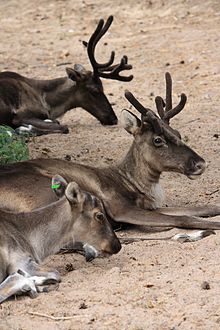Finnish Forest Reindeer
| Finnish forest reindeer | |
|---|---|
 |
|
| Scientific classification | |
| Kingdom: | Animalia |
| Phylum: | Chordata |
| Class: | Mammalia |
| Order: | Artiodactyla |
| Family: | Cervidae |
| Subfamily: | Capreolinae |
| Genus: | Rangifer |
| Species: | R. tarandus |
| Subspecies: | R. t. fennicus |
| Trinomial name | |
|
Rangifer tarandus fennicus Lönnberg, 1909 |
|
|
|
|
|
|
The Finnish forest reindeer (Rangifer tarandus fennicus) (Finnish: metsäpeura, Russian: лесной северный олень) is a rare and threatened subspecies of reindeer native to Finland and northwestern Russia. They are found primarily in Russian Karelia, and the provinces of North Karelia, Savonia and Kainuu in Finland, though some range into central south Finland. They are distinct from the semi-domesticated Northern reindeer (Rangifer tarandus tarandus) in their larger size and preference for dense boreal forest habitat, where they are rarely seen by humans, over the open tundra. They migrate seasonally back and forth across the long Russo-Finnish border.
The Finnish forest reindeer is one of the largest species of reindeer. It is 180–220 cm long and the tail 10–15 cm. The male is larger, weighing 150–250 kg, while females weigh about 100 kg. Their longer legs, wide hooves and narrower V-shaped antlers facilitate movement through deep snow and wooded habitats.
In the 17th century, the Finnish forest reindeer ranged throughout Finland and western Russia. Hunting, reindeer husbandry and habitat degradation through forestry led to their near complete extinction in Finland by the end of the 19th century. In 1700, in Russia the population was concentrated in Kandalaksha (Kantalahti) and Lake Onega (Äänisjärvi) but hunting and reindeer farming wiped them out in that area as well. In 1979 to 1980 they were introduced from Kainuu, Finland to middle Finland to Salamajärvi National Park. A small population of some 1000 also thrive in Southern Ostrobothnia. While their populations have been recovering in Finland, it has been suggested that an increasing, returning wolf population may be partially responsible for slowing the recovery.
...
Wikipedia
